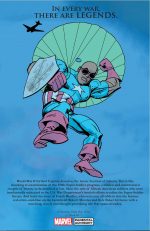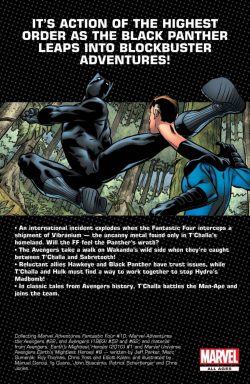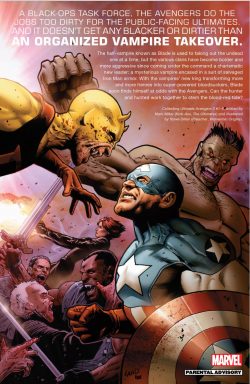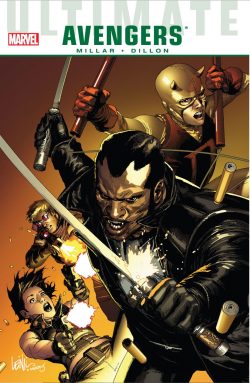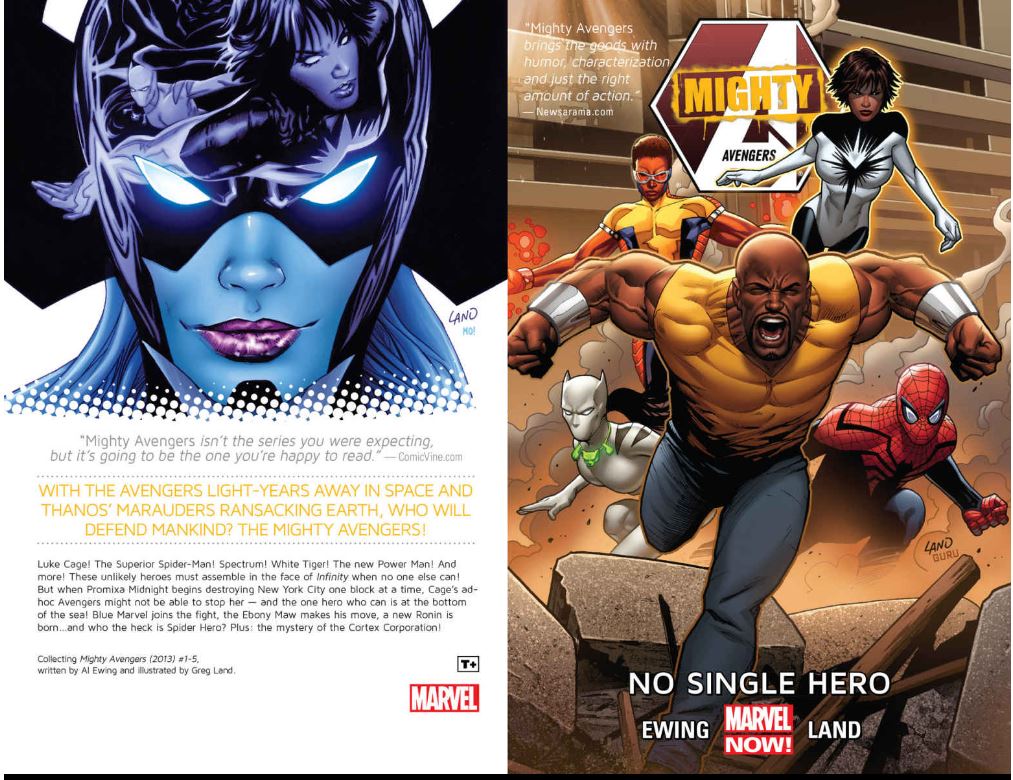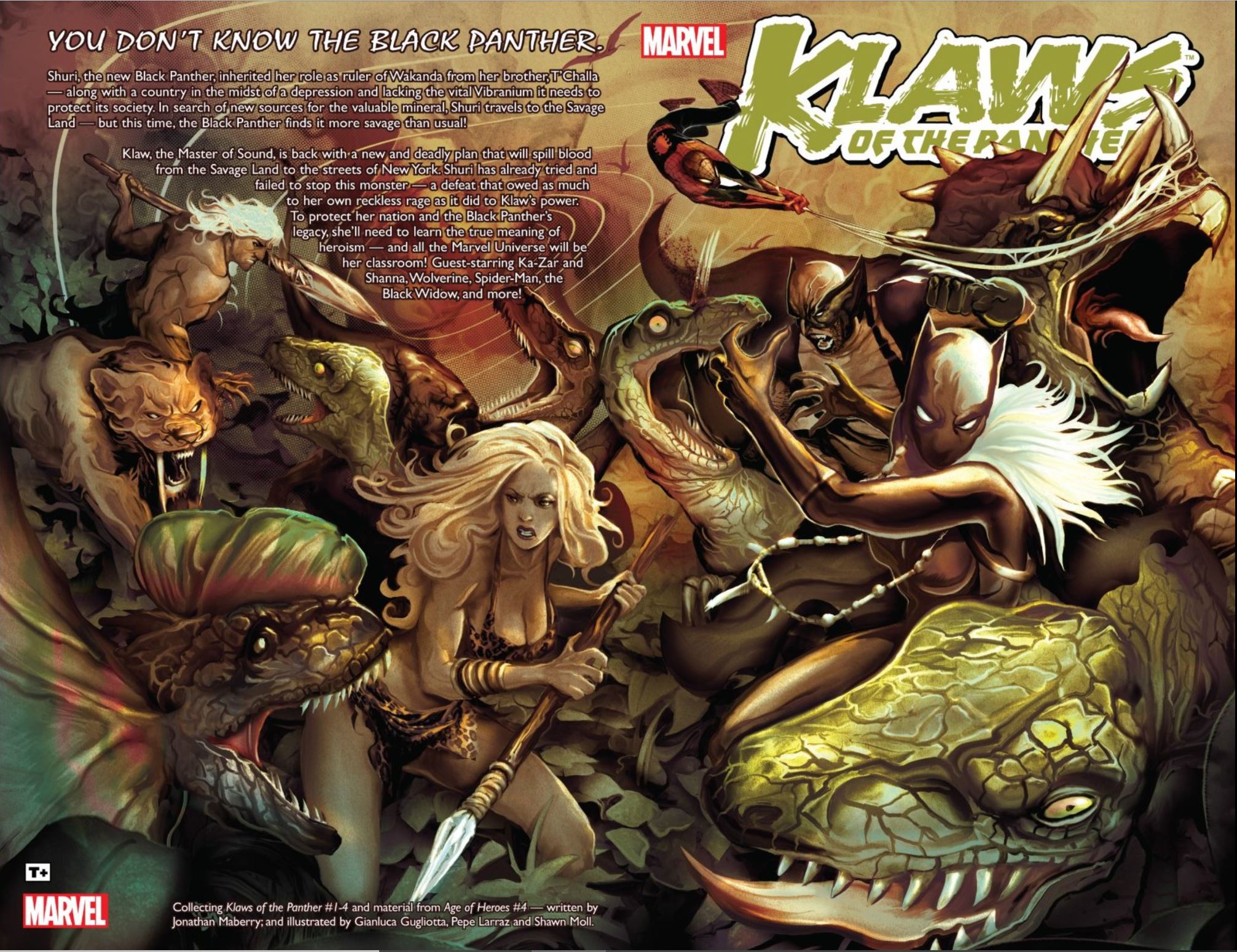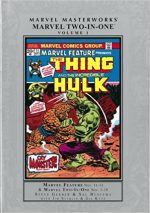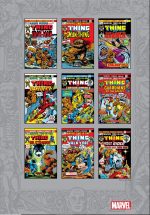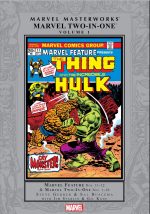

By Jess Harrold, Rodolfo Muraguchi & Adam Del Re with Stan Lee & Jack Kirby, Roy Thomas & John Buscema, Don McGregor, Rick Buckler, Billy Graham & Gene Colan, Ta-Nehisi Coates & Brian Stelfreeze and many & various (MARVEL)
ISBN: 978-1302919382 (HB/Digital edition)
Win’s Christmas Gift Recommendation: Categorically Picture Perfect… 9/10
Celebrated as the first black superhero in American comics and one of the first to carry his own series, the Black Panther’s popularity and fortunes have waxed and waned since the 1960s when he first attacked the FF (in Fantastic Four #52; cover-dated July 1966) as part of an elaborate plan to gain vengeance on the murderer of his father.
T’Challa, son of T’Chaka was revealed as an African monarch whose hidden kingdom was the only source of a vibration-absorbing alien metal upon which the nation’s immense wealth was founded. Those mineral riches – derived from a fallen meteor which struck the continent in primeval antiquity – had powered his country’s transformation into a technological wonderland. That tribal wealth had long been guarded by a hereditary feline-garbed champion deriving physical advantages from secret ceremonies and a mysterious heart-shaped herb that ensured the generational dominance of the nation’s warrior Panther Cult.
After being a steadfast if minor Marvel stalwart for decades, the character and his world finally achieved global stardom thanks to a series of stunning movie interpretations and is now an assured icon of planetary consciousness…
With accumulated years of superb comics material to fall back on, the company would be crazy not to use that in reprints and overviews like this one: creating a resource for new fans to consult and veterans to relish again.
They’re not crazy and this spiffy landscape edition – written by Jess Harrold and designed by Rodolfo Muraguchi & Adam Del Re – came out a couple of years ago. With a sequel in cinemas and the Holiday Season looming, it’s only sensible to point you in this direction if you’re seeking gift suggestions…
Following Introduction ‘Dear Brian…’ by 1990s scripter Christopher J. Priest, what follows is a series of informative, contextualising – but accessibly fun – essays, dotted with candid behind-the-scenes illustrations (like Kirby’s original concept of “The Coal Tiger”), quotes from contributing creators and artwork from classic issues and storylines: tracing the entire career of the Hero/Heroes who have steered Wakanda through Marvel Comics history…
It starts with Chapter One and ‘Enter… The Black Panther!’, with the aforementioned debut and early days supplemented by printed pages, and original art by Kirby & inker Joe Sinnott, highlighting not just the man but especially the astonishingly futuristic kingdom he ruled. As well as origins, there are introductions to concepts and villains who would shape the destinies of the characters and country…
After treading the guest star route, T’Challa got his first regular gig as Captain America’s replacement on the World’s Mightiest Supergroup. ‘Avengers Assemble!’ reprises those walk-ons and traces the solitary hunter’s career as part of a team, with excerpted art and covers from Kirby, John Buscema, Frank Giacoia, Sal Buscema, Rich Buckler, George Tuska, John Romita Sr., Arthur Adams, Marcos Stein and Phil Noto.
‘Panther’s Rage’ reveals how the King faced an existential threat in his homeland as, after policing the Marvel Universe, the summer of 1973 saw the Black Panther finally advance to solo star in his own series. In Jungle Action #6-18, Don McGregor scripted an ambitious epic of love, death, vengeance and civil war: inventing from whole cloth and Kirby’s throwaway notion of a futuristic jungle, the most unique African nation ever imagined…
With art from Rich Buckler, Klaus Janson and Billy Graham, the chapter highlights the unique structure and page design of what is arguably one of comics’ earliest graphic novels. Also provided are the first maps of Wakanda and hits of McGregor’s follow-up tale.
The Panther versus the Klan shifted focus from war stories to crime fiction, replacing exotic Africa for America’s poverty-wracked, troubled, still segregated-in-all-but-name Deep South for a head-on collision with centuries of entrenched and endemic racism. The multi-layered tale ended but did not conclude as Jungle Action was cancelled before its time…
Two months later, under the auspices of returning creative colossus Jack Kirby, a wholly different kind of Black Panther enjoying utterly unrelated adventures was launched, and ‘The Return of the King’ celebrates a new era of excitement.
Kirby’s return proved to be controversial. He was never slavishly wedded to tight continuity and preferred, in many ways, to treat his stints on titles as a “Day One”. His commitment was to wholesome, eye-popping adventure, breakneck action and breathless, mind-boggling wonderment. Combined with his absolute mastery of the comic page and unceasing quest for the Next Big Thrill, it made for a captivating read, but found little favour with those readers fully committed to the minutiae of the Marvel Universe.
With Black Panther #1, what they got was a rollercoaster ride of classic Kirby concept-overload as the Hereditary King of a miraculous Lost Kingdom gallantly pursued fabulous time machines, fought future men and secret samurai clans, thwarted the plots of super-rich artefact stealers and foiled schemes to nuke his hidden homeland, usurp his rule and even consume his faithful subjects. Kirby even introduced an entire, unsuspected extended Royal Family: a Panther clan who would become an intrinsic part of the new mythology.
All this is dynamically revealed in a wave of wonder from Kirby before ‘Where Prowls the Panther?’ explores the 1980s – and a relative dry spell for the hero. Primarily back as a guest star, T’Challa nevertheless completed the “The Klan” saga, revealed a childhood adventure with Storm of the X-Men and closed the decade with a politically-charged miniseries confronting Apartheid. Art contributors here include Jerry Bingham, Al Milgrom, John Byrne, Bob McLeod, Walter Simonson, Steve Rude and Denys Cowan.
Chapter Six examines ‘Panther’s Quest… Panther’s Prey’ when, – as the 1990s began – South Africa’s morally bankrupt ruling system was buckling and became an acceptable target in many creative fields. McGregor returned after years away from the comics mainstream, and with artists Gee Colan & Tom Palmer, spun a shocking tale of intolerance as an epic serial in 25 chapters (published in fortnightly anthology Marvel Comics Presents #13-37, from February to December1989).
One of the most thought-provoking mainstream comics tales ever released, Panther’s Quest reveals how T’Challa infiltrated totalitarian South Africa in search of Ramonda, the beloved stepmother he had believed dead for decades. His hunt for her uncovered conspiracy and abduction, whilst placing him at the forefront of the battle for survival daily endured by the black majority. The saga added pressure to the ever-growing Anti-Apartheid movement in comics and western media, by examining not only the condition of racial inequality but also turning a damning eye on sexual oppression.
It was followed by prestige Limited Series Panther’s Prey, set in Wakanda and again examining the dichotomy of tradition versus progress that had underpinned Panther’s Rage. McGregor’s chilling script was transformed by the art of Dwayne Turner, as seen here in numerous pages and covers from the series, counterpointed by excepts from 2018’s reprise of the tale illustrated by Daniel Acuña from Black Panther Annual #1.
As seen in ‘The Marvel Knight’, T’Challa’s story took a huge leap when Christopher Priest utterly revamped and modernised the hero – and Wakanda – in an epically transformational run. How and why is supported by sketches, designs, finished art and covers by Mark Texiera, Joe Quesada, Joe Jusko, Mike Manley, Sal Velluto, Norm Breyfogle, Andy Kubert, Jim Calafiore, Kyle Hotz, Tomm Coker. Bruce Timm and more.
Screenwriter Reginald Hudlin’s tenure is covered next with ‘Who is the Black Panther?’ as the king takes a wife and full charge of his country in truly perilous circumstances, just as the secret history of Wakanda is revealed at last…
This epic period of change and revelation was supported by many artists and included here are John Romita Jr., Janson, Esad Ribi?, Fran Cho, David Yardin, Scot Eaton, Olivier Coipel, Leinil Francis Yu, Michael Turner, Joseph Michael Linsner, Trevor Hairsine, Mike Deodato Jr., Gary Frank, Nico Henrichon, Simone Bianchi, Arthur Suydam, Cafu, Alan Davis, Francis Portela, Jason Pearson, Jefté Palo and Denys Cowan.
Tribal wealth had always been guarded by hereditary feline champions deriving physical advantages from secret ceremonies and a mysterious heart-shaped herb. This ensured the generational dominance of Wakanda’s warrior Panther Cult. However, in recent years, Vibranium made the country a target for increasing subversion and incursion. After clashes with Namor the Sub-Mariner and an attack by Doctor Doom, T’Challa was forced to render all earthly Vibranium inert, defeating the invader but leaving his homeland broken and economically shattered.
During that cataclysmic clash, the King’s flighty, spoiled brat half-sister Shuri took on the mantle of Black Panther, becoming clan and country’s new champion whilst her predecessor struggled with the disaster he had caused and also recuperated from near-fatal injuries.
Despite initially being rejected by the divine Panther Spirit, Shuri proved a dedicated and ingenious protector, serving with honour until she perished defending Wakanda from alien invader Thanos. When T’Challa resumed his position as warrior-king, one of his earliest tasks was resurrecting his sister. She had passed into the Djalia (Wakanda’s spiritual Plane of Memories) where she absorbed the entire history of the nation from ascended Elders. On her return to physicality, she gained mighty new powers as the Ascended Future…
That’s addressed in rapid succession via ‘Shuri… the Black Panther!’, ‘The Most Dangerous Man Alive!’ and ‘King of the Dead’ – with art from J. Scott Campbell, Ken Lashley, Paul Neary, Paul Renaud, Will Conrad, Romita Jr., Mike Del Mundo, Francesco Francavilla, Simone Bianchi, Andrea Silvestri, Patch Zircher, Giuseppe Camuncoli, Alex Maleev, Adam Kubert, Tom Raney, Steve Epting, Deodato Jr., Jim Cheung, Christian Ward, Valerio Schiti, Kev Walker, Esad Ribi? and Kenneth Rocafort – before ‘A Nation Under Our Feet’ shows how writer Ta-Nehisi Coates and artists Brian Stelfreeze imagined the concept.
That 2016 reinvention again tackled revolution in Wakanda, but also addressed democracy versus autocracy, science against magic, women’s rights, freedom of education and body autonomy whilst telling astounding powerful heroic tales. Stelfeeze’s art and designs are augmented by art and commentary from Chris Sprouse, Wilfredo Torres, Leonard Kirk, Paolo & Joe Rivers and Janie McKelvie & Matthew Wilson.
The series sparked a renaissance and flurry of spin-off titles and ‘The World of Wakanda’
examines that expanded universe, and utilises art by Alitha E. Martinez, Stelfreeze, Jen Bartel, John Cassaday, Butch Guice, Sprouse, Juan Ferreya, Ed McGuiness, Davis, Deodato Jr., Sam Spratt, Leonardo Romero and Kirbi Fagan.
The Panther’s tale pauses here with Coates final storyline ‘The Intergalactic Empire of Wakanda’ as T’Challa abandoned Earth to investigate a vast cosmic tyranny somehow based on his beloved country: a mystery gradually unfolded through the art of Stelfreeze, Acuña and Jen Bartel before we close with ‘Portraits of a Panther’ and a treasure trove of more incredible images that have resulted from the characters and stories preside here. This includes work and commentary by Bianchi, Mike McKone, Alex Ross, Kirby, Skottie Young, Coipel, Neal Adams, Yasmine Putri, Larry Stroman, Acuña, Mike Perkins, Sanford Greene, Jamal Campbell, Inhyuk Lee, Sophie Campbell, Tradd Moore, Natacha Bustos and Ribi?.
Emotionally engaging, powerfully inspirational, and cathartically thrilling, the fictive realm of the Panther People is one that every fan of thrills and lover of wonder should enjoy. This spectacular visual feast is certainly the only guidebook you should need…
© 2020 MARVEL.


